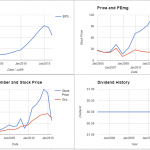The Department of Labor’s Bureau of Labor Statistics has monthly data on employment by industry categories reaching back to 1939. At the highest level, all jobs are divided into two categories: Service-Providing Industries and Goods Producing Industries. The adjacent chart illustrates the ratio of the two categories since 1939.

In 1939 service providing industries employed more people than goods producing, 62.9% to 37.1%, a ratio of 1.7-to-1. World War II triggered a surge in goods producing employment and an accompanying reduction in services. But following the war, we’ve seen a steady trend toward services. The ratio is now 6.3 services jobs for every goods producing job.
The next chart provides a more detailed view of these two employment cohorts. We’ve adjusted for the 380% growth in the employed population since 1939. A conspicuous feature of this snapshot is the sharp trend reversal in the early 1940s reflecting the impact of World War II on the demand for goods. Another notable detail is stable ratio since the last recession. We saw shorter periods of a sustained ratio during the stagflation of the 1970s and for about three years starting at the end of 2003. The current ratio of services to goods producing has been essentially unchanged for over six years.
Another noteable insight is the consistent impact of recessions on the relative growth of the two cohorts: Even though the unemployment rate increases during recessions, the employed service providing population increases and goods producing jobs disappear. We also see that post-recession recoveries don’t reverse this pattern.

The chart above is adjusted for population inflation based on growth the employed population. The next chart focuses on the services providing employed adjusted with a broader population base, the civilian labor force age 16 and over, which includes both the employed and those seeking employment. A striking feature of this chart is its uncanny resemblance to the S&P Composite (the S&P 500 spliced with its predecessor, the S&P 90).














Leave A Comment